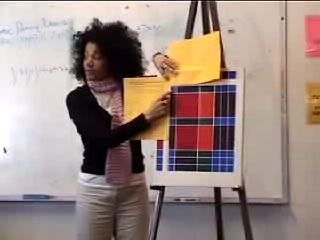In
my work, I combine scaffolding with interdisciplinary group projects
to support learning for those students who are particularly fearful
of mathematics and have a history of failure. Our Colors of Algebra
project has several curricular and pedagogical goals: Students
develop their own unique understanding of algebraic representations;
Presenting on their work elevates the status of student understanding;
Factoring and multiplying are understood and referred to in terms
of dimensions and area; Activities, journal prompts, writing
assignments, and discussions all help students to keep from "talking
off task."
My research delves into the possibilities that may arise when
I combine scaffolding with interdisciplinary group projects to
support learning for those students who are particularly fearful
of mathematics and have a history of failure. While implementing
The Colors & Algebra Project, I will consider the following
questions:
1. How much math are the students really absorbing?
2. To what extent are mathematical concepts being broached by my efforts to
support the development of academic language and motivation?
3. To what extent do students increase the use of academic language and how
authentic is its use?
A series of carefully selected video clips will provide you
with a sense of how scaffolding strategies in combination with
the project experience come together for presentations. It is
here that you will see and read about 1) how I reflect on my
assumptions about what it means to support student learning 2)
how I address it, 2) and how students respond.
The emphasis on "toolkits" as a means for building
and using mathematical langugage is demonstrated here. Toolkits
are compiled over the course of the year. Each student has their
own recording of toolkits that can be used during tests. I also
require students to refer to them during group work and use them
as resources. The specific toolkits here are the same ones listed
in the presentation grade sheet: combining like terms, factoring,
multiplying, dimensions, area.
Lesson Outline/Detailed Description:
Day 1: Groups agree on their own names for Lab Gear blocks
based on the 1 block and use of dimensions. Teacher leads class
to agreed upon names 1,5,25, x, 5x, y, 5y, x², y²,
xy.
Days 2-5: Students use Lab Gear and worksheets to practice
and develop multiplication of variables and factoring.
Days 5-10: Painting project begins and ends and daily
painting activities are guided by journal questions.
 The Colors of Algebra
The Colors of Algebra